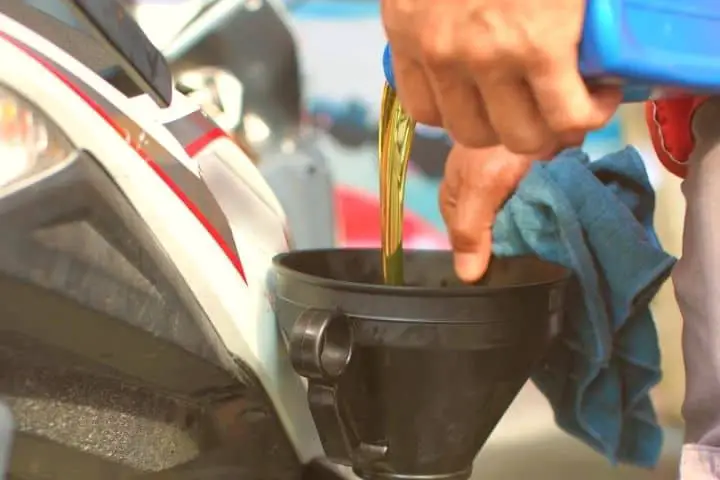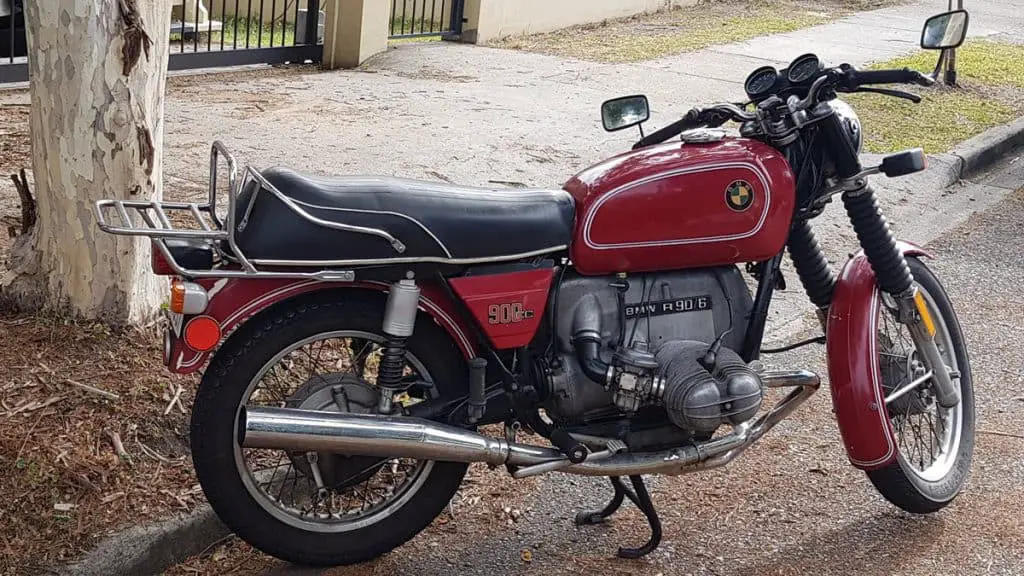Can I Use 10w30 Instead of 5w30 Oil – The Ultimate Guide to Multi-Grade Engine Oils
Allow me to start with a warning.
If you’re a newcomer to the world of motorcycles, there’s a lot to get confused about.
And one of the areas where many newbies get baffled is choosing the right lubricating oil for your engine.
So let me rephrase the question: what if I put 10w30 instead of 5w30 in the engine?
To answer that, we need to look into some of the technical mumbo jumbo behind multi-grade oils.
Relax. It’s not as complicated as it sounds.
What Does 5W30 or 10W30 Actually Mean?
To start with, let’s uncover the secret of those cryptic numbers or oil grades.
For that, you need to understand the concept of viscosity.
(Wait a minute. I am in energy-saving mode today.)
In a nutshell, viscosity is the force acting between the molecules of a fluid flowing on a surface. In other words, the more viscous a fluid is, the slower it moves.
Viscosity is affected by factors like temperature, pressure, and the nature of the fluid.
When we are talking about motor oil weight, it’s the viscosity grade that is spoken of. So, the Society of Automotive Engineers (SAE) developed a nomenclature system for grading oils of various viscosities.
Viscosities can vary between 0 to higher numbers like 60. Now, 0 indicates the lowest viscosity or the thinnest oil. As you go higher, the viscosity increases and the oil becomes thicker.
Single-grade oils come with a fixed viscosity. The lower the number, the better it flows in cold temperatures.
However, in the case of multi-grade oils, the viscosity and the oil behaviour can vary with the temperature. Such oils have special chemical ingredients that allow you to use them at different temperatures.
Let’s take the 5W30 oil as an example. Here’s what the name means:
- The number 5 indicates the viscosity or thickness and determines how the oil flows at 32 degrees Fahrenheit or at cold temperatures. The lower the number, the better the oil flows at colder temperatures without getting thick.
- “W” stands for “Winter” which indicates cold temperatures.
- The number “30” stands for the viscosity of the oil when it is hot or at 212 degrees Fahrenheit.
Obviously, the oil passes to different viscosity grades as the temperatures vary. But these numbers indicate the highest and lowest viscosities that it can have.
Similarly, the SAE 10W30 oil will have a low viscosity of 10 when cold and high viscosity of 30 when the engine gets hot.
Why Do We Need a Multi-Grade Oil?

Good question.
And the answer isn’t so difficult if you think about it.
Natural oil becomes less viscous or thinner when temperatures rise. Conversely, when temperatures drop, it gets thicker.
But when it comes to the engine of a car or a motorcycle, this isn’t what we want. There are two reasons for that.
- When you start the engine, it’s in a cold state. At this stage, thin oil that can move freely and circulate faster through all the parts effectively is needed. Natural oil which is thicker at cold temperatures won’t flow easily. So, it won’t get the job done.
- The situation is reversed when the engine gets hot. At high temperatures, you need a thick oil that sticks to the various parts and provides effective lubrication and protection. Again, any natural oil that gets thinner at a high temperature isn’t good enough for the purpose.
That’s the reason why synthetic multi-grade engine oils have an opposite behavior when compared to natural oils. They are thin at cold temperatures and thick at hot temperatures.
It goes without saying, choosing the right oil is a must for your motorcycle engine. Since engines have multiple moving parts, the amount of friction between them is very high.
The engine oil lubricates these components to keep them running under high operating temperatures. In addition, it also cleans the contaminants that can produce sludge and reduce engine performance.
Beyond that, synthetic oils are extremely stable and very hard to break down. They also last longer and produce less sludge and deposits in the long run.
That said, make sure you follow the oil change interval as recommended by the brand.
One more thing…
If you look back, there was a time when 20W-50 or 10W- engine oils were a popular choice. But with advancements in engine technology, the spaces between components have gotten narrower.
This has resulted in the rise in the use of thinner oils like 5W30 or 0W20.

Which Oil Is Better – 5W30 or 10W30?
Let me get this straight.
There’s no “better” or “best” engine oil. Each synthetic oil designed as per the SAE standards is good for a range of conditions.
5W30 and 10W30 are two of the most common synthetic oils that are found in the market.
The fact of the matter is both these synthetic oils are quite similar in nature.
Except when it comes to cold weather performance. The 10W30 oil is more viscous or thicker than the 5W30 oil in cold conditions.
When it comes to modern engines, experts believe that the maximum amount of wear occurs as the engine is warming up. So an oil like 5W30 that’s thinner at colder temperatures can be a better choice.
That said, the best engine oil for your motorcycle is the one recommended by the manufacturer. Deviating from the recommendations can put extra stress on the engine and cause serious damage to it.
End result: your bike won’t last long.
For example, if you use a thicker engine oil than recommended, more power will be needed to pump it through the engine components. That will generate more heat and reduce the lubricating properties of the oil.
However, in some cases, manufacturers might mention a range of engine oils you can use. In that case, you can choose the best option depending on your environment.
(Okay. So a rider in Iceland wouldn’t choose the same oil as a rider in Mali.)
If you live in arctic conditions, the 5W30 oil will be a better choice than a 10W30. In hotter climates, a thicker oil like 15W40 should be a better choice.
Now, let’s consider a 5W-20 and a 5W-30 oil.

Both oils will have similar performance at low temperatures. But as the temperatures rise, the 5W20 oil will have lower viscosity. So it will move freely and deliver better fuel economy.
At the same time, due to its lower thickness, it will not form a thick film of protection around the engine components. So 5W30 oil is thicker and provides better lubrication at higher temperatures.
Moral of the story…
Unless you know the exact requirements of the engine components, you can’t pick the right oil that delivers the best results.
5W30 Vs 10W30: A Quick Comparison
Let’s get back to the original question.
Is it ok to use 10w30 instead of 5w30?
To find the answer, you need to take a look at the major differences between the two oil types.
Viscosity
Let’s go back to the numbers before “W” in these two types of oil.
Since the 5W30 oil has the lower number before “W”, It indicates a low viscosity grade. So the thickness of the oil will be less in lower temperatures. That makes 5W30 a better choice for lower temperatures.
In other words, the 10W30 oil will not flow as freely as 5W30 at low temperatures. The temperature range within which it works isn’t that high.
The ideal ambient temperature range for 10W30 oil is between -22 to 95 degrees Fahrenheit. In the case of 5W30, it’s -31 to 95 degrees Fahrenheit.

But that doesn’t mean 10W30 oil isn’t suitable for colder temperatures. In fact, both oils are graded for winter performance.
When it comes to high-temperature performance, both the oils have the same viscosity as a single grade SAE 30 oil. So they will have a similar thickness when the engine reaches operating temperature.
Vehicle Type
The 5W-30 multi-grade oil can be used in light-duty petrol and diesel engines including motorcycles. light vans and other passenger vehicles. It’s best suited for vehicles operating in colder temperatures.
The 10W30 oil is slightly thicker and works best for high-capacity engines and commercial vehicles. It’s also a better choice for older engines as it
Efficiency
Since 5W30 is a thinner oil, with lower viscosity, it can reach the innermost parts of an engine more easily. So, it can have better cooling efficiency in lower temperatures.
When it comes to 10W30, it’s a thicker oil. That means it’s not as good as reaching the internal parts of the engine that easily.
So what does all this mean?
In extremely cold conditions, 10W30 will not provide the best lubrication. So you should replace it with 5W30. But make sure to check the manufacturer’s recommendations first.
(Great timing. I’m running on fumes here.)
Frequently Asked Questions

Will the wrong engine oil damage my engine?
Wrong engine oil can damage your bike’s engine in many ways. The wrong oil will not be able to lubricate the engine properly. The excess friction can also generate extra heat and burn the oil. Also, if you use thicker oil at lower temperatures, it might get difficult to start the engine.
When should I switch from 5W30 to 10W30?
You can switch from 5W30 to 10W30 when you’re changing your ride conditions from extremely low temperatures to slightly higher temperatures. But make sure that both the oils are recommended by the manufacturer.
What if I put 10w30 instead of 5w30?
If you have made the mistake of using 10w30 instead of 5w30, it won’t damage your engine drastically during a single ride. But the 10W30 oil is thicker and isn’t the best choice for lower temperatures.. So, unless you’re heading for higher temperatures, stick to the manufacturer’s recommendations.





